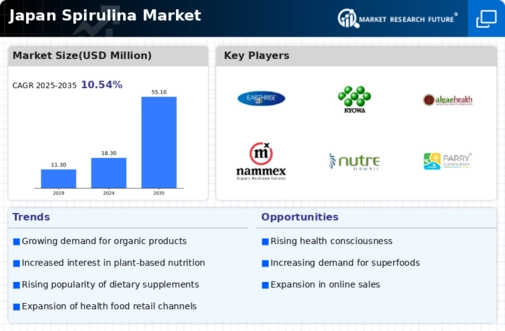Rising Interest in Plant-Based Diets
The spirulina market is witnessing a shift towards plant-based diets, which is influencing consumer purchasing behavior. As more individuals adopt vegetarian and vegan lifestyles, the demand for plant-derived protein sources has escalated. Spirulina, being a blue-green algae, is recognized as a potent plant-based protein alternative, appealing to health-conscious consumers. In Japan, the plant-based food market is expected to grow at a CAGR of around 8% over the next five years, indicating a favorable environment for the spirulina market. This trend suggests that the industry may see increased product innovation and marketing strategies targeting this demographic.
Growing Popularity of Functional Foods
The spirulina market is benefiting from the increasing popularity of functional foods, which are foods enhanced with additional health benefits. Spirulina is often marketed as a superfood due to its high nutrient density and potential health benefits, such as boosting immunity and improving energy levels. In Japan, the functional food market is projected to grow significantly, with consumers increasingly seeking products that offer health benefits beyond basic nutrition. This trend suggests that the spirulina market may see a rise in product diversification and marketing efforts aimed at highlighting the functional attributes of spirulina, thereby attracting a broader consumer base.
Government Support for Health Initiatives
The Japanese government has been actively promoting health initiatives aimed at improving the overall well-being of its population. This support includes encouraging the consumption of superfoods like spirulina, which are recognized for their health benefits. The spirulina market stands to gain from government-backed campaigns that advocate for healthier eating habits. With the government investing in public health education, the awareness of spirulina's nutritional advantages is likely to increase. This could potentially lead to a rise in sales and consumption of spirulina products, further solidifying its position in the market.
Technological Advancements in Cultivation
Technological advancements in the cultivation of spirulina are playing a crucial role in enhancing production efficiency and product quality. Innovations in aquaculture and bioprocessing techniques are enabling producers in the spirulina market to optimize growth conditions and yield. For instance, the implementation of controlled environment systems has been shown to increase spirulina production by up to 30%. As these technologies become more accessible, the spirulina market is likely to experience a boost in supply, meeting the rising consumer demand for high-quality spirulina products. This could also lead to competitive pricing strategies, benefiting consumers.
Increasing Demand for Nutritional Supplements
The spirulina market in Japan is experiencing a notable surge in demand for nutritional supplements. This trend is largely driven by a growing awareness of health and wellness among consumers. As individuals increasingly seek natural sources of nutrition, spirulina, known for its high protein content and rich array of vitamins and minerals, has gained popularity. Recent data indicates that the market for dietary supplements in Japan is projected to reach approximately $10 billion by 2026, with spirulina products contributing significantly to this growth. The spirulina market is thus poised to benefit from this increasing consumer inclination towards health-enhancing products.

















Leave a Comment